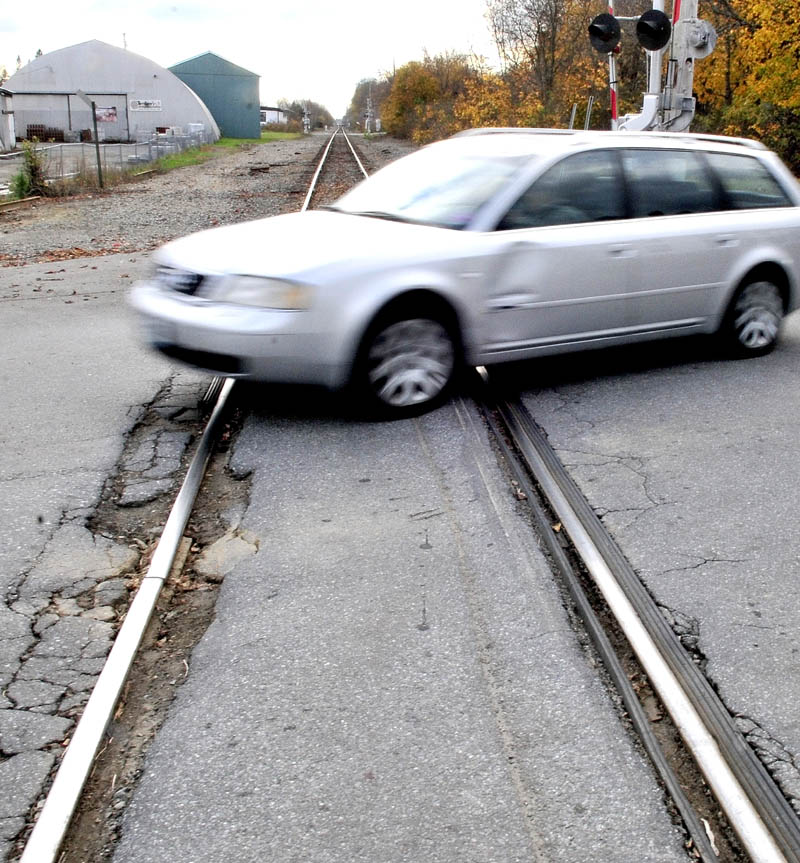FAIRFIELD — A solution may finally be in the works for the decrepit railroad crossings in town, which have been the subject of complaints for years.
This week, the town began working with the Maine Department of Transportation and Pan Am Railways to get cost estimates for repairs that could include closing one or two crossings and badly needed repair work on several more.
Nearby Benton resident Ken Spencer said the crossings are so bad that cars have to ease over potholes and ridges as they attempt to get from one side of the railroad to the other.
“People from the area slow down anticipating it, but strangers don’t know that,” he said. “If I hit one of those holes on my motorcycle, I would be killed.”
Town Manager Josh Reny said the town council will consider three options in which the town could close one or two railroad crossings, help pay to rebuild the crossings or simply allow the railroad to do the repairs on its own over a lengthier timetable that would span years.
The federal government’s railroad safety program associates railroad crossings with accidents and deaths, so it provides grant money to subsidize projects that include the closing of existing railroad crossings, Reny said.
Two of the three options take advantage of federal money that would be received for closing at least one crossing.
In the first option, the town would close one of the seven crossings in Fairfield’s intown area, which would attract federal grant money that could subsidize repairs on other crossings. The number of other crossings that would be repaired would depend on how much the town would be willing to spend on a collaborative project with Pan Am and the state. Reny said that the ballpark estimate to rebuild a single crossing is about $40,000 or $50,000.
In a similar collaborative project last year, the town of Clinton paid about $4,000 toward work on a single crossing and another $20,000 to repave the road on each side of the crossing.
In the second option, the town would close two crossings, which would attract enough grant money to rebuild the other four crossings. In this scenario, Pan Am would then spend additional money to rebuild a one-mile stretch of rail from the railroad bridge at the southern end of town to a crossing at U.S. Route 201.
“That is an incredible safety improvement,” Reny said. “If they’re rebuilding all of that, it’s going to be more stable. There’s something to be said about what value that provides to the people of Fairfield, to know that they have new and safe tracks running through their town.”
In the third option, Pan Am would commit to repairing the crossings without any public money but Reny said the timetable and the quality of the repairs would be less appealing.
“It might take them several years,” he said. The repairs at the crossings would only extend 18 inches from either side of the tracks, which Reny said would be likely to degrade within a few years of the repair.
The Town Council has not committed to any of the three options and Reny said Fairfield residents would be asked to weigh in on the issue at one or more public hearings.
Reny said members of the public will have to consider the costs and benefits of closing one or two crossings.
In an email to the town earlier this week, Pan Am’s vice president of engineering, James Patterson, proposed the town close crossings at Burrill and Elm streets, which would allow for the rebuilding of crossings on Summit Street, Willow Street, Lawrence Avenue, Western Avenue and U.S. Route 201.
Reny said that the little-used Elm Street crossing would be a likely choice in the event of one closing and that there were arguments to support the closing of a second crossing on Burrill or Willow streets.
Reny said the rebuilding of the crossings will help Fairfield to be a more attractive place in the eyes of residents and visitors.
“The town wants to be welcoming to people driving through,” he said.
Pan Am Railways, based in North Billerica, Mass., operates more than 300 miles of track in Maine.
Reny said if an agreement could be reached by early in 2013, the work could be completed during the 2013 construction season.
A slower process could see the work done in 2014.
Matt Hongoltz-Hetling — 861-9287
mhhetling@centralmaine.com
Send questions/comments to the editors.



Success. Please wait for the page to reload. If the page does not reload within 5 seconds, please refresh the page.
Enter your email and password to access comments.
Hi, to comment on stories you must . This profile is in addition to your subscription and website login.
Already have a commenting profile? .
Invalid username/password.
Please check your email to confirm and complete your registration.
Only subscribers are eligible to post comments. Please subscribe or login first for digital access. Here’s why.
Use the form below to reset your password. When you've submitted your account email, we will send an email with a reset code.